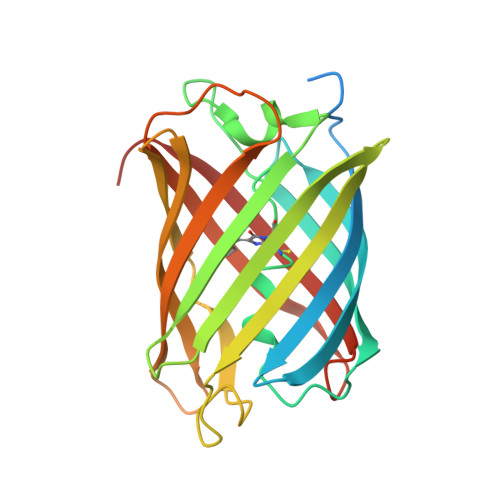1.8 A bright-state structure of the reversibly switchable fluorescent protein Dronpa guides the generation of fast switching variants
Stiel, A.C., Trowitzsch, S., Weber, G., Andresen, M., Eggeling, C., Hell, S.W., Jakobs, S., Wahl, M.C.(2007) Biochem J 402: 35-42
- PubMed: 17117927
- DOI: https://doi.org/10.1042/BJ20061401
- Primary Citation of Related Structures:
2IOV - PubMed Abstract:
RSFPs (reversibly switchable fluorescent proteins) may be repeatedly converted between a fluorescent and a non-fluorescent state by irradiation and have attracted widespread interest for many new applications. The RSFP Dronpa may be switched with blue light from a fluorescent state into a non-fluorescent state, and back again with UV light. To obtain insight into the underlying molecular mechanism of this switching, we have determined the crystal structure of the fluorescent equilibrium state of Dronpa. Its bicyclic chromophore is formed spontaneously from the Cys62-Tyr63-Gly64 tripeptide. In the fluorescent state, it adopts a slightly non-coplanar cis conformation within the interior of a typical GFP (green fluorescent protein) b-can fold. Dronpa shares some structural features with asFP595, another RSFP whose chromophore has previously been demonstrated to undergo a cis-trans isomerization upon photoswitching. Based on the structural comparison with asFP595, we have generated new Dronpa variants with an up to more than 1000-fold accelerated switching behaviour. The mutations which were introduced at position Val157 or Met159 apparently reduce the steric hindrance for a cis-trans isomerization of the chromophore, thus lowering the energy barrier for the blue light-driven on-to-off transition. The findings reported in the present study support the view that a cis-trans isomerization is one of the key events common to the switching mechanism in RSFPs.
Organizational Affiliation:
Department of NanoBiophotonics, Max-Planck-Institute for Biophysical Chemistry, Am Fassberg 11, 37077 Göttingen, Germany.















